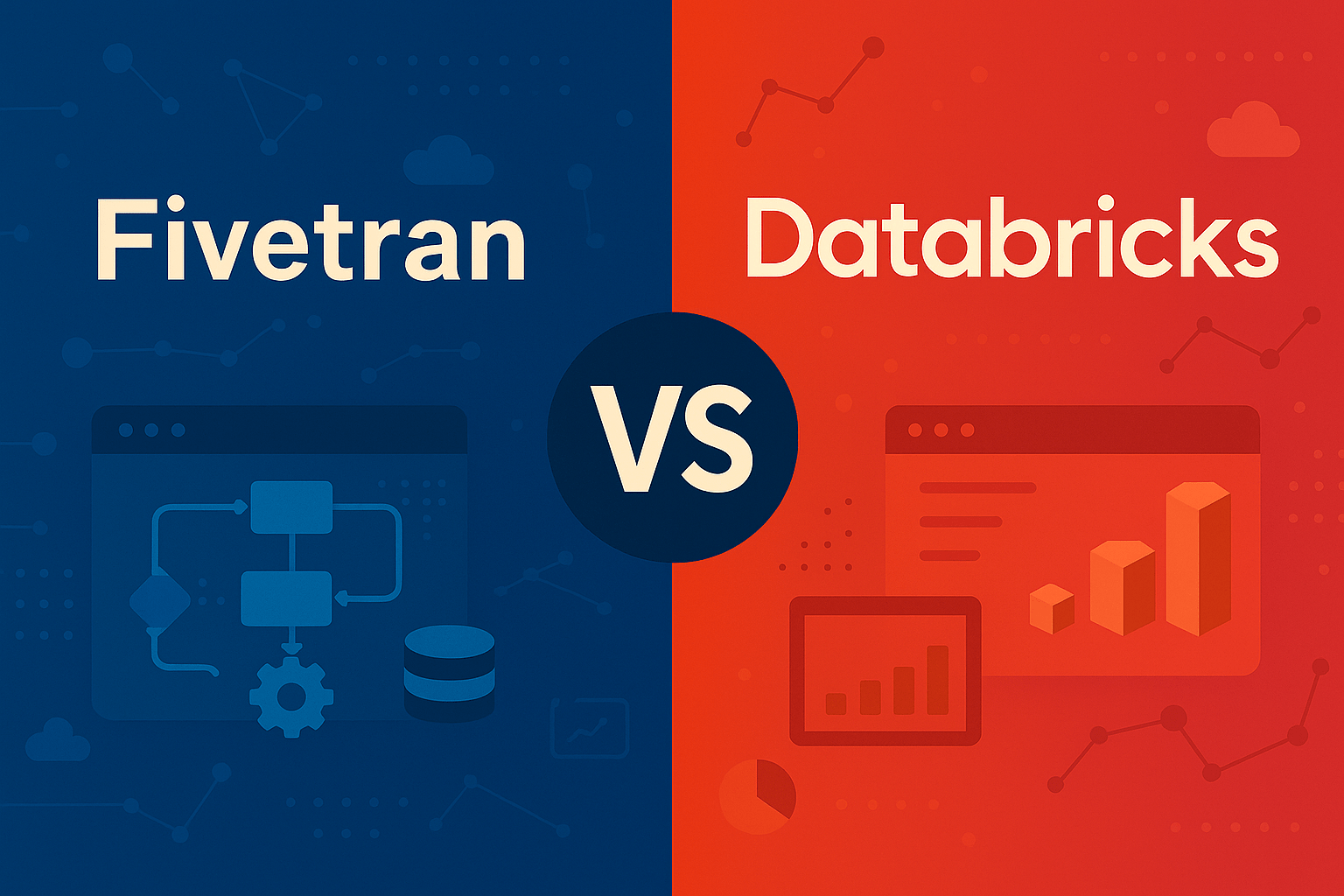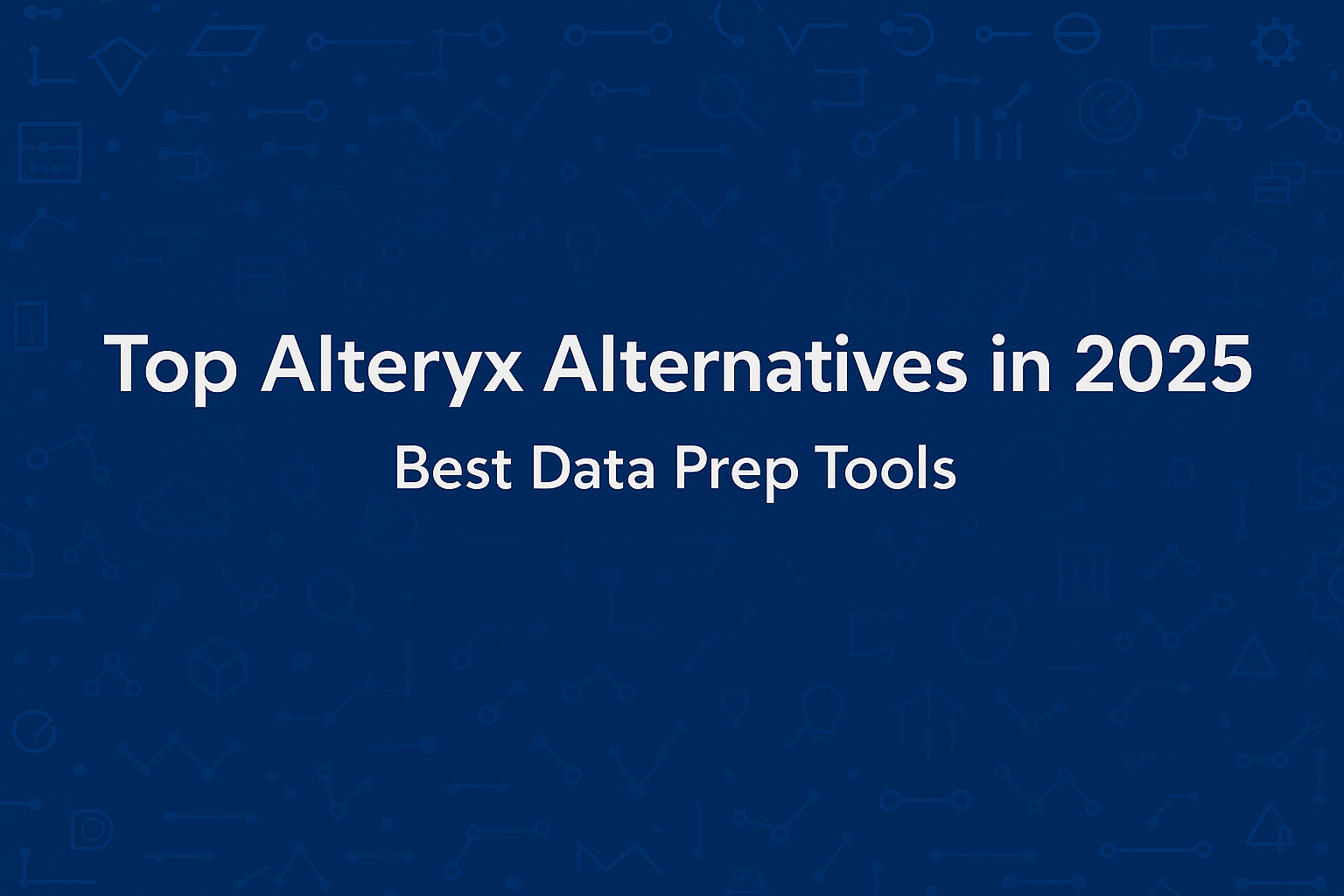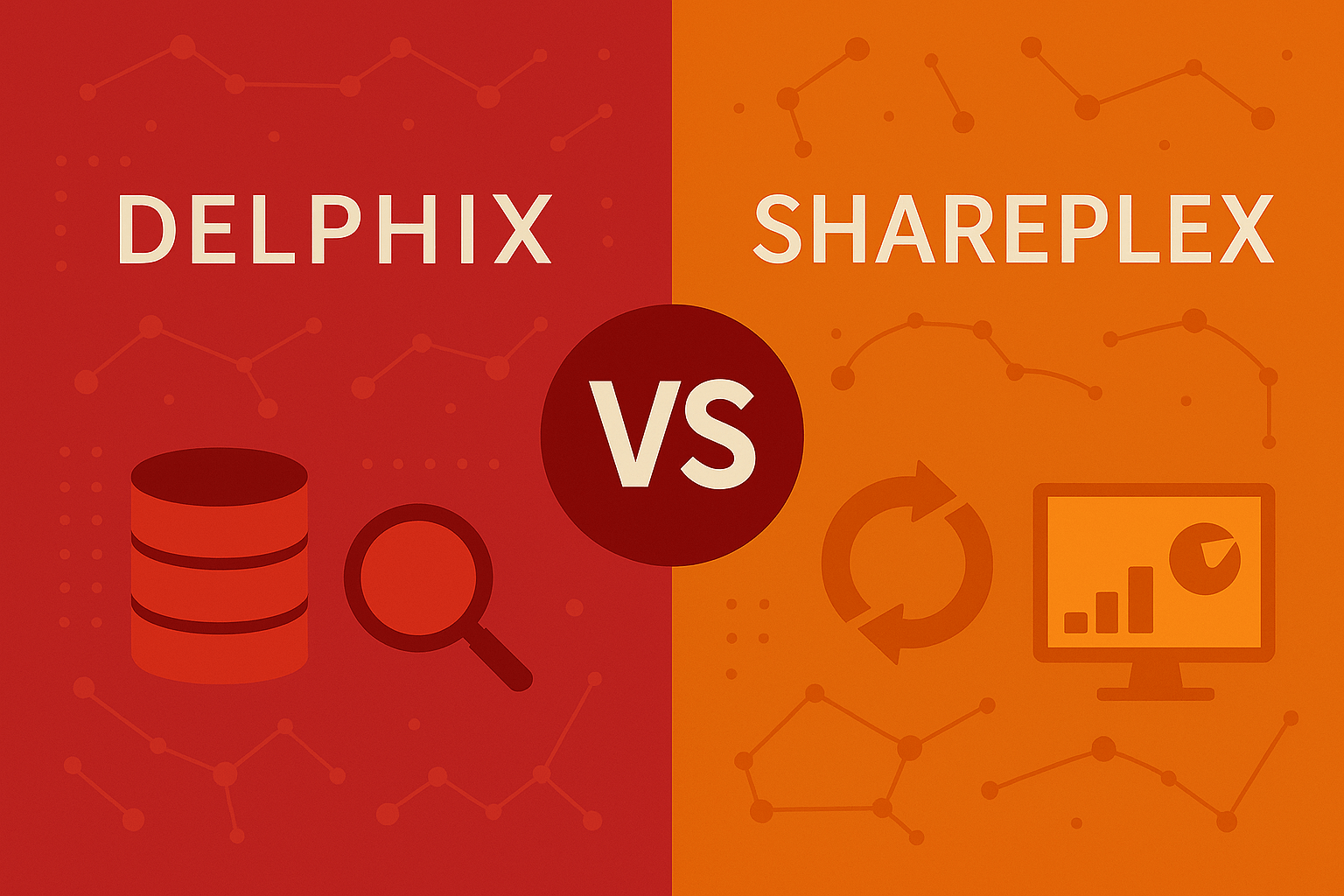Looking for the best KNIME alternatives for your data science needs?
This guide lists the top 11 alternatives to KNIME in 2025, with each one’s strengths and use cases. Read on to find the right tool for your projects.
Overview of KNIME Platform

Image Source: KNIME
KNIME Analytics Platform is a free, open-source data analytics and machine learning tool that allows users to build, execute, and share data workflows through an intuitive, low-code interface. It supports over 300 data connectors and integrates with popular machine learning libraries, enabling users to access, blend, analyze, and visualize data from various sources. KNIME is designed for both beginners and experienced data professionals, offering a modular, extensible platform for tasks ranging from data preparation and analysis to model deployment and reporting.
The 11 Best KNIME Alternatives & Competitors for 2025

KNIME alternatives require understanding each platform’s unique strengths. Here’s a quick look at the top contenders:
-
Best for Manufacturing Data Integration and Automation: Factory Thread
-
Best for Collaborative Data Science Projects: Dataiku
-
Best for Low-Code Machine Learning: RapidMiner
-
Best Open-Source Machine Learning Platform: H2O.ai
-
Best for Microsoft Ecosystem Integration: Azure Machine Learning
-
Best for Fully Managed Machine Learning Services: SageMaker
-
Best for Google Cloud Integration: Vertex AI
-
Best for Model Tracking and Deployment: MLflow
-
Best for Educational and Research Settings: JupyterHub
-
Best for Beginners in Data Science: Orange
-
Best for Unified Analytics: Databricks Data Intelligence Platform
Factory Thread – Best for Manufacturing Data Integration and Automation
.png?width=650&height=105&name=FactoryThread_Horizontal_Black%20(650%20x%20105%20px).png)
Factory Thread is a modern data virtualization platform purpose-built for manufacturing. It connects production, quality, and business systems in real time without duplicating data. With low-code design, AI assistance, and built-in governance, Factory Thread enables seamless operations across on-prem, edge, and cloud environments—ideal for plants with high security demands or limited internet access.
Why Factory Thread is the Top KNIME Alternative in 2025
While KNIME is known for general-purpose data analytics, Factory Thread stands out in manufacturing environments by offering pre-built connectors, AI-assisted workflows, and real-time dashboards specifically designed for operational use cases. Its ability to federate data across MES, ERP, and IoT systems—without centralizing or copying—makes it uniquely powerful for fast, reliable decision-making on the factory floor.
Factory Thread is ideal for:
Factory Thread is designed for manufacturing engineers, plant operators, and business analysts who need to:
-
Sync work orders, track KPIs, and analyze production in real time
-
Integrate legacy systems and modern cloud tools without disruption
-
Automate routine processes with minimal coding
-
Monitor and scale data pipelines securely in regulated environments
Factory Thread vs KNIME: 2025 Comparison
|
Feature / Aspect |
Factory Thread |
KNIME |
|---|---|---|
|
Primary Use Case |
General-purpose data analytics and machine learning |
|
|
Target Users |
Manufacturing engineers, plant operations teams, business analysts |
Data scientists, analysts, researchers |
|
Integration Capabilities |
Pre-built connectors for MES, ERP, CRM, SQL, REST APIs, flat files; real-time unified data access |
Broad range of connectors including big data, databases, cloud platforms |
|
Deployment Options |
Cloud, on-premises, and edge (supports offline operations) |
Desktop and server/cloud via KNIME Server |
|
Workflow Interface |
Low-code, visual drag-and-drop; AI-assisted workflow builder; domain-specific blocks |
Visual programming via nodes; more flexible for advanced custom nodes |
|
AI Features |
Generative AI to auto-generate workflows based on user prompts |
Limited AI support; mostly manual configuration |
|
Monitoring & Alerts |
Real-time dashboards, alert system, flow health tracking |
Limited monitoring; mostly batch analytics |
|
Data Virtualization |
Federated access without duplication, supports live querying (REST, GraphQL, OData) |
Data is usually imported; limited native virtualization |
|
Security & Governance |
Role-based access, encryption, audit trails, governance dashboards |
Role-based access via KNIME Server; less focus on real-time governance |
|
Collaboration Features |
Self-service data catalog, version history, multi-language UI |
Strong team features via KNIME Server |
|
Industry Focus |
Manufacturing-specific; optimized for quality, production, scheduling, and KPI analytics |
Industry-agnostic; used across finance, healthcare, academia, etc. |
|
Learning Curve |
Steeper for non-manufacturing users; intuitive for manufacturing teams |
Easier for general data professionals; rich documentation and community |
|
Cost |
Not publicly listed; likely enterprise-priced |
Free desktop version; commercial licenses for collaboration and deployment |
Summary
-
Factory Thread is ideal for manufacturers seeking robust integration, real-time automation, and operational dashboards with minimal coding.
-
KNIME is better suited for general data science workflows with a broad community and flexible node-based analysis.
Dataiku - Best for Collaborative Data Science Projects

Price: $3,500 to $4,000 per seat per year
Pros:
-
Full toolset for data science projects
-
Both coding and no-code workflows
-
Collaboration among diverse teams
Cons:
-
Production features are costly
-
User interface can be confusing
Dataiku promotes collaboration within data teams through a full platform for the data science project lifecycle. Key features include:
-
Visual workflows
-
Notebook integration
-
AutoML
-
Production deployment These features allow technical and non-technical users to contribute.
Despite its many capabilities, Dataiku’s cost for production features and sometimes confusing user interface may be a challenge for some organizations. Organizations facing these challenges may want to explore alternatives to Alteryx. But it facilitates collaboration among diverse teams, including data scientists, analysts and business users so it’s a great tool for organizations that want to stay competitive in the fast-paced world of data science.
RapidMiner - Best for Low-Code Machine Learning

Price: Various pricing options, including a free community edition
Pros:
-
Friendly for analysts transitioning from KNIME.
-
Low-code platform.
-
Both paid business licenses and free community edition
Cons:
-
Limited advanced coding options for experienced data scientists
-
Enterprise features are costly
RapidMiner is for analysts and teams transitioning from KNIME to a more user-friendly tool. The drag-and-drop interface simplifies data preparation, modeling and validation. As a low-code platform, RapidMiner does machine learning, predictive analytics and predictive modeling without requiring extensive programming knowledge.
While RapidMiner has a free community edition and paid business licenses, enterprise features can be costly for some organizations. Experienced data scientists may find the limited advanced coding options restrictive. But RapidMiner is a powerful tool to simplify complex data analytics tasks and enable users to get insights.
H2O.ai - Best Open-Source Machine Learning Platform

H2O.ai is an open-source machine learning platform for both enterprise and researchers. Key features:
-
Multiple machine learning algorithms (ensemble methods and deep learning)
-
Versatile for different users
-
Good distributed computing for large datasets
The web-based interface is easy to use but not for all users. Complexity for beginners too. But H2O.ai is great for AutoML and code-first workflows so it’s good for smaller orgs due to free version and affordable pricing.
Pros:
-
For both enterprise and researchers
-
Code-first workflows and APIs for Python, R, and Java
-
Good for AutoML and distributed computing
Cons:
-
Web-based interface not for all users
-
Complex for beginners
Azure Machine Learning - Best for Microsoft Ecosystem Integration

Price: N/A
Pros:
-
Integrates well with existing Microsoft tools and systems
-
Full support for building, training and deploying machine learning models
-
User-friendly
Cons:
-
Pricing is complex
-
Requires Microsoft ecosystem knowledge
Azure Machine Learning is great for Microsoft aligned teams. It has visual pipelines and code-based development for different users. As a cloud service it makes building, training and deploying machine learning models easy.
Despite the user-friendly interface and powerful data processing, the complex pricing and Microsoft ecosystem knowledge may be a challenge for some users. But Azure Machine Learning is a must-have for orgs looking to leverage AI and machine learning within the Microsoft framework.
SageMaker - Best for Fully Managed Machine Learning Services

Price: $0.10 per hour for training instances, $0.05 per hour for hosting instances.
Features
-
Fully managed service
-
Supports multiple machine learning frameworks
Pros:
-
Complete infrastructure for building and deploying ML models
-
Model tuning
-
Scalable for any project size
Cons:
-
Complex for beginners
-
Costs add up for heavy usage
Amazon SageMaker is a fully managed platform for training, tuning and deploying machine learning models. It simplifies building and deploying ML models so teams can focus on model optimization. It supports multiple machine learning frameworks and has advanced features like model tuning.
While SageMaker’s infrastructure and scalability is great for engineering teams, it’s complex for beginners. Costs can add up for heavy usage. But SageMaker streamlines machine learning and accelerates time to market so it’s a must-have for businesses.
Vertex AI - Best for Google Cloud Integration

Price: Varies based on usage and services used.
Features
-
Complete machine learning platform
-
Integrates with Google Cloud services
Pros:
-
Well integrated with Google Cloud services
-
Customizable pipelines for business needs
Cons:
-
Bad documentation
-
Bad support
-
Bugs everywhere
Vertex AI has options for building AI models, code-first and visual. Within Google Cloud Platform, Vertex AI unifies custom training, AutoML, pipelines and model serving to make data more accessible and processable.
But users have reported issues with the API and documentation which can be frustrating for those not deeply familiar with Google Cloud ecosystem. Despite that, Vertex AI is good for businesses due to its strong integration with Google Cloud services.
MLflow - Best for Model Tracking and Deployment

Price: N/A
Features:
-
Experiment tracking
-
Operationalization endpoints
Pros:
-
Governance and security
-
New model URI format
-
Logging feature
Cons:
-
Limited advanced features for customization
-
Steep learning curve
MLflow has APIs for tracking experiments, logging parameters, metrics and artifacts during model training. It links metrics to specific model checkpoints and associated datasets for better performance traceability, perfect for production environments focused on model deployment.
While MLflow’s governance and security ensures data privacy, its limited advanced features for customization and steep learning curve for beginners may be a challenge. But MLflow’s utility in the machine learning lifecycle makes it worth it for teams.
JupyterHub - Best for Educational and Research

Price: Free
Features
-
Multiple user interfaces
-
Deploy for small teams and large institutions
Pros:
-
Shared computational resources
-
Customizable
-
Multiple authentication methods
Cons:
-
Setup and maintenance
-
Not for high performance computing
JupyterHub allows users to access shared computational resources without individual installations or maintenance. Supports multiple interfaces like Jupyter Notebook, Jupyter Lab and RStudio, JupyterHub is versatile for various workflows.
Although setup and maintenance is required, JupyterHub can handle deployments for small teams and large institutions so it’s good for educational settings. Customizable and multiple authentication methods provide controlled access for users in the organization so students have a consistent connection.
Orange - Best for Beginners in Data Science

Price: Free
Features
-
GUI data mining tool
-
Academic or early stage use cases
Pros:
-
Simplifies data mining and machine learning
-
No programming skills required
-
For experimentation and learning
Cons:
-
Limited features for experienced data scientists
-
Not scalable for large complex projects
Orange, a GUI data mining tool, simplifies data mining and machine learning tasks including text mining. Its interface is intuitive so beginners can do data analysis and machine learning without advanced programming languages skills, so it’s accessible for newcomers.
Although it has limited advanced features for experienced data scientists, Orange is good for academic or early stage use cases, a platform for newcomers to experiment and learn data mining techniques. Its simplicity and usability makes it a great tool for beginners.
Databricks Data Intelligence Platform - Best for Unified Analytics

Price: Pricing varies based on usage.
Features
-
Data engineering, machine learning and analytics
-
Serverless data warehousing
Pros:
-
Comprehensive solution for data engineering, machine learning and analytics
-
SQL analytics for batch and streaming data processing
Cons:
-
Pricing can be complex and high for larger operations
-
Requires data engineering expertise for optimal use
Databricks combines data engineering, machine learning and analytics into one solution, a powerful platform for unified analytics. Its serverless big data warehousing supports SQL analytics for batch and streaming data processing, making data workflows more flexible and scalable.
Its architecture uses a lakehouse model, integrating data storage and processing to streamline analytics and data governance. However, its complex and potentially high pricing and need for data engineering expertise can be a challenge for some. Despite these, Databricks is a top choice for those looking for a unified analytics platform.
How to Choose the Right KNIME Alternative
Choosing the right KNIME alternative can be overwhelming with many options. Focus on the following:
-
Features and capabilities each platform offers.
-
Collaboration needs: platforms like Dataiku has strong real-time collaboration features.
-
Integration requirements: tools like SageMaker or Vertex AI has seamless integration with cloud-native infrastructure.
-
Usability: platforms like RapidMiner and Orange, known for their user-friendly interfaces, are great for beginners or those transitioning from KNIME.
-
Scalability: platforms that support distributed computing and parallel processing like H2O.ai can handle large datasets.
Integration should be prioritized. Azure Machine Learning and Vertex AI has excellent integration with their ecosystem so workflows are seamless for users already invested in Microsoft or Google Cloud. Cost is also a factor; some platforms can be expensive. Dataiku for example has many features but at a higher cost, justified by its comprehensive toolset and collaboration features.
Lastly, community support and resources can impact your decision. Platforms that integrate community contributions and has robust support like MLflow can help project success by providing valuable insights and smooth onboarding. By considering these factors you can choose a KNIME alternative that fits your organization’s needs and help you achieve your data science goals.
Conclusion
In summary, exploring alternatives to the KNIME analytics platform can open up new possibilities for your data science projects. Whether you’re looking for a platform that excels in collaboration features like Dataiku or one that has seamless integration with your existing cloud services like Azure Machine Learning or Vertex AI, there’s a tool out there for you. From low-code solutions like RapidMiner to comprehensive open-source platforms like H2O.ai, each alternative has its strengths.
By considering the features, usability, scalability, integration capabilities and cost of each platform you can make an informed decision that will support your data science initiatives. Remember the right tool can boost your team’s productivity, streamline your workflows and ultimately drive better business outcomes. So take the time to explore these alternatives and find the one that’s right for you.
FAQs
What is the best KNIME alternative for collaborative data science projects?
Dataiku is the best alternative for collaborative data science projects because of its strong collaboration features and comprehensive toolset for managing the entire data science lifecycle.
Which platform is good for manufacturing data integration and automation?
Factory Thread is the best platform for manufacturing data integration and automation, it has seamless integration across production, quality and business systems.
Are there any low-cost or free alternatives to KNIME?
There are low-cost or free alternatives to KNIME such as RapidMiner’s free community edition and H2O.ai’s free version. These can meet your data analysis needs without breaking the bank.
Which platform is best for users already in the Microsoft ecosystem?
Azure Machine Learning is the best platform for users already in the Microsoft ecosystem as it has seamless integration with existing Microsoft tools and systems. This makes life easier for users.
Share this
You May Also Like
These Related Stories

Fivetran vs Databricks: Which Data Platform is Right for Your Business?

Top Alteryx Alternatives and Competitors (for 2025)



No Comments Yet
Let us know what you think